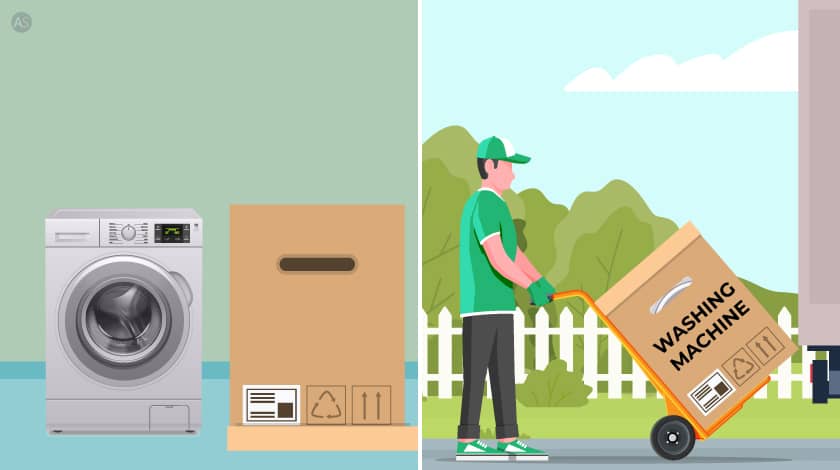9 Easy Steps to Move Your Washing Machine Securely

Moving a washing machine is more complicated than you think. They are bulky, delicate and have many working parts that need to be handled with care. On average, washers can weigh between 60 kg to 90 kg, while some larger washing machines can weigh up to 120 kg.
If you are planning a move to a new home or simply shifting your washing machine to a new location within the house, it's important to know how to handle the process. This blog will provide you with a step-by-step guide to moving your washing machine, ensuring a smooth and stress-free experience.
{"preview_thumbnail":"/sites/default/files/styles/video_embed_wysiwyg_preview/public/video_thumbnails/md2h5N4Ds04.jpg?itok=nc13LvEf","video_url":"https://youtu.be/md2h5N4Ds04","settings":{"responsive":1,"width":"854","height":"480","autoplay":1},"settings_summary":["Embedded Video (Responsive, autoplaying)."]}
Steps to Move Your Washing Machine
-
Read the Manual
Before you start your move, it is recommended that you read the instruction manual which can give an overall idea of how to disconnect and reconnect your washing machine before and after the move safely.
A manual will also help to understand what specific materials are necessary for transporting or whether certain components must be left secured or detached a certain way during the move.
-
Gather the Required Packing Supplies
You will need proper packing supplies and moving equipment to relocate your washing machine successfully. Here are what you will need to move your washing machine.
- Wrench
- Pliers
- Washing machine cleaners
- Packing tape
- Cardboard or foam
- Moving blanket
- Dolly
- Rope or bungee cords
-
Clean the Washer
Run an empty load on a warm cycle or a drum clean cycle, you can add cleaning agents such as bleach or white vinegar instead of detergent, during the empty run. This will thoroughly clean the machine and eliminate any odour left in it. Spin dry and leave the door and detergent compartment open for a full 48 hours to air dry.
Wipe and clean the interior of the door seal to remove mould and detergent residues. Clean out your filter, which is located on the front of the washing machine, and collect all little objects such as lint, tissues, coins, socks, and so on.
-
Unplug the Power Outlet
Switch off the power switch and unplug the washing machine from the outlet. Tape the power wire to the washing machine to keep it secure.
-
Detach the Water Hose
Turn off the water supply and detach the water supply hoses from the back of the machine. Ensure your machine is completely drained to prevent any damage during the move.
Remove the drain hose from the machine and allow the water to drain into the sink or a bucket. Once all of the water has been drained, remove the hose and carefully wrap it to avoid damage during transport.
-
Protect The Drum
There are high chances of damage caused to your appliance’s suspension system when moving. To prevent them you need to stabilise the washing machine’s drum from excessive motion during the move.
-
For Front Loaders
To stabilise the drum, install the transit bolts in the back of your washing machine. This will help to keep the drum in place while being transported.
-
For Top-Loaders
Top-loaders will not have transport bolts; nevertheless, you can protect the drum by putting padding material such as cardboard or foam between the drum and the casing.
-
Protect The Washer
Tape down all locks and doors, then cover your washing machine in 3 to 4 furniture blankets to protect it from dents and scratches during truck transport. Secure the blankets well to the washer with packing tape or shrink wrap.
-
Moving The Washing Machine
Once the washer is prepped and securely packed, use a dolly to move the washing machine. Secure your machine to the dolly with bungee cords or strong rope.
Washing machines should be kept in an upright position to prevent unwanted issues such as damaged suspension, loose pads or knocking your washer out of alignment, which can occur if you place your washer on its side or back and it doesn’t shift during transit.
-
Reinstallation at the New Place
Once you've successfully relocated your washing machine, make sure you remove the transit bolts and anything else you've placed within the drum during the relocation. Reattach the input and output hoses, plug the machine back in, and turn on the water supply. It is also a good practice to conduct an empty test cycle to confirm that your washer is operational following the move.
Conclusion
Moving a washing machine is a difficult undertaking since they are massive appliances and it is important to properly plan and prepare the appliances to ensure secure moving. By following the steps outlined in this blog, you can successfully move the large electrical appliance such as a washing machine without causing any damage to them.
Make sure you enlist the assistance of friends or a professional team on the move day. Hiring a professional mover is the best option as they can manage every element of your relocation, from packing to loading to transporting and reinstalling the items at the new location and help save you time and effort.











